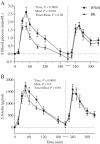Effects of indigestible carbohydrates in barley on glucose metabolism, appetite and voluntary food intake over 16 h in healthy adults
- PMID: 23577719
- PMCID: PMC3639862
- DOI: 10.1186/1475-2891-12-46
Effects of indigestible carbohydrates in barley on glucose metabolism, appetite and voluntary food intake over 16 h in healthy adults
Abstract
Background: Recent knowledge in animals suggests that gut microbial metabolism may affect host metabolism, including appetite regulating hormones. The aim of the present study was to evaluate the potential effects of a whole grain barley kernel product, rich in intrinsic indigestible carbohydrates (dietary fibre and resistant starch), on markers of metabolism and appetite regulation in healthy subjects.
Methods: Boiled barley kernels (BK) or white wheat bread (WWB; reference) were provided as late evening meals to 19 young adults in random order using a cross-over design. During subsequent ad libitum standardized breakfast and lunch meals (10.5-16 h), blood was collected for analysis of glucose, plasma insulin, adiponectin, ghrelin, glucose-dependent insulinotropic polypeptide (GIP) and glucagon-like peptide-1 (GLP-1), serum free fatty acids (FFA) and interleukin (IL)-6. In addition, appetite sensations, voluntary energy intake and breath H2 were determined.
Results: BK as evening meal increased plasma GLP-1 at fasting (P < 0.05) and during the experimental day (P < 0.01) compared with WWB. In addition the BK evening meal decreased fasting serum FFA (P < 0.05) and tended to decrease fasting serum IL-6 (P = 0.06). At lunch, preceded by BK evening meal, voluntary energy intake was decreased (P < 0.05) when compared to WWB evening meal. The BK evening meal decreased incremental blood glucose area (P < 0.01), promoted higher breath H2 (P < 0.001), maintained adiponectin concentrations (P < 0.05) and reduced perceived hunger (P < 0.05) during 10.5-16 h after the meal.
Conclusions: The results indicate that the BK evening meal, facilitate glucose regulation, increase the release of GLP-1, reduce subsequent energy intake while at the same time decreasing hunger over 2 subsequent meals, and reduce fasting FFA the subsequent morning, possibly mediated through gut microbial fermentation of the indigestible carbohydrates.
Figures






References
-
- Alberti KGMM, Zimmet P, Shaw J. Metabolic syndrome—a new world-wide definition. A Consensus Statement from the International Diabetes Federation. Diabet Med. 2006;23:469–480. - PubMed
-
- Diabetes Fact sheet N°312. [ http://www.who.int/mediacentre/factsheets/fs312/en/index.html] - PubMed
-
- Good CK, Holschuh N, Albertson AM, Eldridge AL. Whole Grain Consumption and Body Mass Index in Adult Women: An Analysis of NHANES 1999–2000 and the USDA Pyramid Servings Database. J Am Coll Nutr. 2008;27:80–87. - PubMed
-
- Harland JI, Garton LE. Whole-grain intake as a marker of healthy body weight and adiposity. Public Health Nutr. 2008;11:554–563. - PubMed
Publication types
MeSH terms
Substances
LinkOut - more resources
Full Text Sources
Other Literature Sources
Medical

